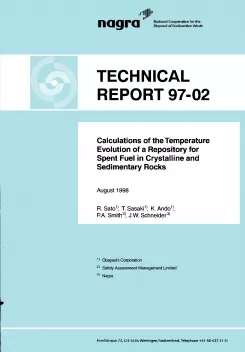
Technical Report NTB 97-02
Calculations of the Temperature Evolution of a Repository for Spent Fuel in Crystalline and Sedimentary Rocks
Thermal evolution is a factor influencing repository design, and must be considered in safety assessment, since many of the processes that affect the long-term safety are temperature dependent. This report presents calculations of the thermal evolution of a repository for spent nuclear fuel. The calculations are based on a provisional repository near-field design in which spent fuel is encapsulated in composite copper-steel canisters, which are emplaced centrally along the horizontal axes of repository tunnels, with the space around the canisters backfilled with bentonite.
The temperature of these near-field components varies with time, due to the radiogenic heat produced by the spent fuel. The rate of heat production per canister depends on the initial composition of the fuel, its reactor history, the period of intermediate storage before final disposal and the loading of the canisters. The rate decreases with time, as shorter-lived radionuclides decay. The base-case calculation considers spent fuel that is assumed to generate 1000 Watts per canister, 40 years after unloading of the fuel from the reactor. The results of the base case calculation indicate that the temperatures at the bentonite/host rock interface, at the centre of the bentonite and at the bentonite/canister interface rise to 98°C, 103°C and 126°C, respectively, before declining towards the ambient temperature of the host rock which, in the base case, is taken to be the crystalline basement of Northern Switzerland.
In addition to the base case, parameter variations are examined that investigate the sensitivity of thermal evolution to alternative heat output, design specifications and to uncertainties in material properties. Key findings include (i), that an increase in heat generation to 1500 W per canister 40 years after unloading results in a significant increase of repository temperatures (e.g. at the bentonite/host rock interface, an increase of 22°C is observed), (ii), that a decrease in tunnel spacing from 20 m (base case) to 10 m gives significantly increased temperatures, while an increase to 40 m has a less pronounced effect on thermal evolution, (iii), that the thermal properties of the bentonite and host rock are less sensitive parameters, with lower near-field temperatures calculated for increased thermal conductivities and heat capacities, (iv) that the presence of air gaps within and around the bentonite has little effect on thermal evolution, as do changes to longitudinal canister pitch and tunnel diameter and (v), that lower temperatures are calculated for a repository at a depth of 600 m in the Opalinus Clay host rock (principally due to the shallower repository depth and therefore lower ambient rock temperature) than for a repository at 1200 m depth in the crystalline basement of Northern Switzerland. Temperatures in the middle and outer parts of the bentonite are reduced by about 10°C if the depth of the repository in crystalline is reduced to 900 m.
